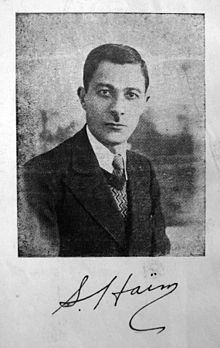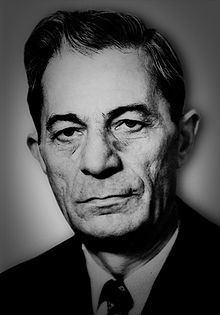Name Solayman Haim Role Translator | Spouse Azizagha Bakhshitarzan | |
 | ||
Born c. 1887
Tehran, Iran ( 1887-01-26UTC06:17:01 ) Occupation lexicographer, translator, essayist, poet Died February 14, 1970, Tehran, Iran Books Persian - English Dictionary, Farhang moaser | ||
Solayman Haïm (also Soleyman Soly Haïm or Soleiman Haïm), whose dictionaries appeared in English under the name Sulayman Hayyim (Persian: سلیمان حییم) (c. 1887 in Tehran, Iran – February 14, 1970 in Tehran), was an Iranian lexicographer, translator, playwright and essayist, often called "Iran's Father of the bilingual dictionary".
Contents
Biography
Haïm was born into an Iranian Jewish family. His father Haïm Eshāq was a quilter. both of his parents were Kalimis (Iranian Jews) of Shirazi origin who had migrated to Tehran. Haïm started his education in a Maktabkhaneh (traditional type of elementary school) called Noor that belonged to Christian missionaries in Tehran. He learned the Hebrew language and religious matters from the well-known Hakham Haïm Moreh and became his pupil and assistant when Moreh became blind. He continued his studies in Ettehad secondary school, where he learned French and Hebrew. He was 19 when he entered the American High School (later renamed American College, and yet later Alborz High School), which was run by a group of American missionaries under the supervision of the legendary Samuel M. Jordan. At the college, young Solayman excelled in English, Persian literature, and music. He then started to teach English in 1915 at American College. Soon after, he began working on the first series of bilingual dictionaries printed in Persian, a task that earned him the honorary name "Word Master." Later, he switched to translation. He is known to have worked for the Iranian Ministry of Finance for a number of years as a translator to Dr. Arthur Millspaugh, an American adviser to Iranian government on fiscal matters.

He then moved on to the Anglo-Iranian Oil Company, where he headed the translation bureau until his retirement in the 1950s. His first published work (1928) is a play, Yusof va Zoleikha, based on the story of Joseph and Potiphar’s wife Zuleikha, from the Old Testament. Haim wrote this play to be performed by the students of Alliance school. His first reference work, the New English–Persian Dictionary, in two volumes, was published in 1929–31. This was later replaced by the Larger English–Persian Dictionary, and never reprinted.
He knew French, Hebrew, English and Persian, and produced bilingual dictionaries in French and Hebrew as well as English. He also wrote a compilation of Persian proverbs and their English equivalents with the name "A Book of Collected Poems". Besides Yusof va Zoleikha, he wrote the plays "Esther and Mordecai" and "Ruth and Naomi". Besides writing these plays and composing their music, Haim also directed and performed in them. Moreover, he translated and contributed to articles in the Persian Encyclopedia that dealt with matters relating to the Jewish faith.
Soleyman Haim died in 1970 at the age of 82, with many projects left incomplete. Dariush Haim, Davood Adhami, Jahanguir Banayan, and Manouchehr Amiri have each written about their personal memories of Haim. Among the Jewish minorities in modern Iran, belongs Soleyman Haiim to the rare instances, who has invested his spiritual und material capital in Human Sciences. The majority of Persian Jews living in Iran are rather interested in Natural Sciences particularly in medicine. Nevertheless, Farshid Delshad فرشید دلشاد (born 1972)–one the far descendants of Soleyman Haim–might be considered as an exception who has been specialized in Historical-Comparative Linguistics and has published nationally and internationally monographs and papers in Iranian Studies and Philology.
Haïm was fond of Persian history and literature, and the divans of Sa'di and Hafez were his favourite books. He also was an amateur poet.
Haïm's English–Persian and Persian–English dictionaries
Below is a list of Haïm’s English–Persian and Persian–English dictionaries:
